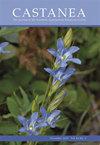Responses of Florida Scrub Vegetation to Water Additions from a Groundwater Treatment Project and to Hurricane Disturbance
IF 0.3
4区 生物学
Q4 PLANT SCIENCES
引用次数: 1
Abstract
ABSTRACT Florida scrub is a fire-maintained shrub vegetation of well-drained, sandy soils; dominant species include several species of Quercus and Serenoa repens. In a remediation project, treated groundwater was distributed through an exfiltration gallery into intact scrub. We established eight permanent line-intercept transects (15 m length) in the site in April 2002, four close to the exfiltration gallery and four more distant from it. We sampled vegetation, <0.5 m and ≥0.5 m, along each transect and measured vegetation height at four points (0, 5, 10, 15 m) annually through 2019. The initial phase of the project operated from October 2002 to early March 2004 (494 days) and distributed 1.74 × 108 L of water. The final phase of the project occurred from March 2005 through August 2008 (1,251 days) and distributed 1.90 × 108 L of water. Pumping raised the water table near the exfiltration gallery. Vegetation height did not differ between the near and far transects initially. Vegetation height increased in the near transects by 2004 with the greatest percent change in 2003 and 2004 as did total cover ≥0.5 m. Total cover <0.5 m and bare ground were similar initially in the near and far transects and declined in the near transects by 2004. Scrub species, particularly the dominant scrub oaks, increased height and cover in response to water additions with no loss of dominant scrub species and no establishment of mesophytes. Hurricane Frances (September 2004) reduced cover ≥0.5 m the following year. Hurricane Matthew (October 2016) and Hurricane Irma (September 2017) caused greater damage including breaking limbs as reflected in reduced height and total cover ≥0.5 m probably because the older, taller scrub was more vulnerable to wind damage.佛罗里达灌木丛植被对地下水处理项目增加的水量和飓风扰动的响应
佛罗里达灌丛是一种疏水性良好的沙质土壤,以火维持的灌木植被;优势种包括栎属和栎属几种。在一个修复工程中,处理过的地下水通过一个渗漏通道分布到完整的灌丛中。2002年4月,我们在场地上建立了8个永久截线样条(长度为15米),其中4个靠近渗漏廊,4个远离渗漏廊。我们沿着每个样带采样<0.5 m和≥0.5 m的植被,并在每年的4个点(0、5、10、15 m)测量植被高度,直至2019年。首期工程运行时间为2002年10月至2004年3月初(494天),配水量1.74 × 108升。最后一期工程于2005年3月至2008年8月(1251天),分配水量1.90 × 108 L。抽水提高了渗漏通道附近的地下水位。植被高度在近、远样带间基本没有差异。近样带植被高度呈增加趋势,其中2003年和2004年变化幅度最大,总覆盖度≥0.5 m;总覆盖度<0.5 m和裸地在近、远样带初始相似,到2004年近样带逐渐下降。灌丛树种,特别是优势灌丛栎树,对加水的响应增加了高度和盖度,但没有损失优势灌丛树种,也没有建立叶生植物。飓风弗朗西斯(2004年9月)使次年的覆盖面积减少了0.5米以上。飓风马修(2016年10月)和飓风伊尔玛(2017年9月)造成了更大的破坏,包括断肢,这反映在高度降低和总覆盖面积≥0.5 m上,这可能是因为年龄更大、更高的灌木丛更容易受到风害。
本文章由计算机程序翻译,如有差异,请以英文原文为准。
求助全文
约1分钟内获得全文
求助全文
来源期刊

Castanea
生物-植物科学
CiteScore
0.50
自引率
25.00%
发文量
28
审稿时长
>12 weeks
期刊介绍:
Castanea is named in honor of the American Chestnut tree. Castanea is thebotanical name for Chestnuts, dating back to what the ancient Greeks calledthem.
The American Chestnut is a critically endangered tree that once made up 35%of the forests of the Eastern US before being devastated by a blight thatdestroyed up to 4 billion American Chestnut trees.
Castanea serves professional and amateur botanists by reviewing andpublishing scientific papers related to botany in the Eastern United States.
We accept papers relating to plant biology, biochemistry, ecology, floristics,physiology and systematics.
 求助内容:
求助内容: 应助结果提醒方式:
应助结果提醒方式:


